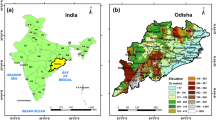Abstract
Climate affects malaria transmission through a complex network of causative pathways. We seek to evaluate the impact of hypothetical climate change scenarios on malaria transmission in the Sahel by using a novel mechanistic, high spatial- and temporal-resolution coupled hydrology and agent-based entomology model. The hydrology model component resolves individual precipitation events and individual breeding pools. The impact of future potential climate shifts on the representative Sahel village of Banizoumbou, Niger, is estimated by forcing the model of Banizoumbou environment with meteorological data from two locations along the north–south climatological gradient observed in the Sahel—both for warmer, drier scenarios from the north and cooler, wetter scenarios from the south. These shifts in climate represent hypothetical but historically realistic climate change scenarios. For Banizoumbou climatic conditions (latitude 13.54 N), a shift toward cooler, wetter conditions may dramatically increase mosquito abundance; however, our modeling results indicate that the increased malaria transmissibility is not simply proportional to the precipitation increase. The cooler, wetter conditions increase the length of the sporogonic cycle, dampening a large vectorial capacity increase otherwise brought about by increased mosquito survival and greater overall abundance. Furthermore, simulations varying rainfall event frequency demonstrate the importance of precipitation patterns, rather than simply average or time-integrated precipitation, as a controlling factor of these dynamics. Modeling results suggest that in addition to changes in temperature and total precipitation, changes in rainfall patterns are very important to predict changes in disease susceptibility resulting from climate shifts. The combined effect of these climate-shift–induced perturbations can be represented with the aid of a detailed mechanistic model.









Similar content being viewed by others
References
Baup F, Mougin E, de Rosnay P, Timouk F, Chênerie I (2007) Surface soil moisture estimation over the AMMA Sahelian site in Mali using ENVISAT/ASAR data. Remote Sensing of Environment 109:473-481
Bomblies A, Duchemin J, Eltahir EAB (2008) Hydrology of malaria: model development and application to a Sahelian village. Water Resource Res 44:W12445. doi:10.1029/2008WR006917
Claussen M (1998) On multiple solutions of the atmosphere-vegetation system in present-day climate. Global Change Biology 4:549-59
Craig MH, Snow RW, le Sueur D (1999) A climate-based distribution model of malaria transmission in sub-Saharan Africa. Parasitology Today 15(3):105-111
D’Amato N, Lebel T (1998) On the characteristics of the rainfall events in the Sahel with a view to the analysis of climatic variability. International Journal of Climatology 18:955-974
Depinay JM, Mbogo CM, Killeen G, Knols B, Beier J, Carlson J, Dushoff J, Billingsley P, Mwambi H, Githure J, Toure AM, McKenzie FE (2004) A simulation model of African Anopheles ecology and population dynamics for the analysis of malaria transmission. Malaria Journal 3:29
Detinova TS (1962) Age Grouping Methods in Diptera of Medical Importance. Geneva: World Health Organization
Foley JA, Coe MT, Scheffer M, Wang G (2003) Regime shifts in the Sahara and Sahel: interactions between ecological and climatic systems in northern Africa. Ecosystems 6:524-539
Giannini A, Saravanan R, Chang P (2003) Oceanic forcing of Sahel rainfall on interannual to interdecadal time scales. Science 302(5647):1027-1030
Hoelzmann P, Jolly D, Harrison SP, Laarif F, Bonnefille R, Pachur H-J (1998) Mid-Holocene land-surface conditions in northern Africa and the Arabian peninsula: a dataset for the analysis of biogeophysical feedbacks in the climate system. Global Biogeochemical Cycles 12(1):35-51
Ijumba JN, Lindsay SW (2001) Impact of irrigation on malaria in Africa: paddies paradox. Medical and Veterinary Entomology 15(1):1-11
Irizarry-Ortiz M, Wang G, Eltahir EAB (2003) Role of the biosphere in the mid-Holocene climate of West Africa. Journal of Geophysical Research 108(D2):4042. doi:10.1029/2001JD000989
Jepson WF, Moutia A, Courtois C (1947) The malaria problem in Mauritius: the bionomics of Mauritian anophelines. Bull Entomol Res 38:177-208
Kiszewski A, Teklehaimenot A (2004) A review of the clinical and epidemiologic burdens of epidemic malaria. American Journal of Tropical Medicine and Hygiene 71(Suppl 2):128-135
Lamb PJ (1978) Case studies of tropical Atlantic surface circulation patterns during recent sub-Saharan weather anomalies: 1967 and 1968. Monthly Weather Review 106(4):482-491
Le Barbé L, Lebel T (1997) Rainfall climatology of the Hapex–Sahel region during the years 1950–1990. Journal of Hydrology 188-189:43-73
Lebel T, Sauvageot H, Hoepffner M, Desbois M, Guillot B, Hubert P (1992) Rainfall estimation in the Sahel: The EPSAT-Niger experiment. Hydrology Science Journal 37:201–215
Martens W (1997) Health Impacts of Climate Change and Ozone Depletion: An Eco-Epidemiological Modelling Approach. Dept. Mathematics, University of Maastricht, Maastricht
Molineux L, Gramicci G (1980) The Garki Project. Geneva: WHO. 311 pp
Mutero CM, Kabutha C, Kimani V, Kabuage L, Gitau G, Ssennyonga J, Githure J, Muthami L, Kaida A, Musyoka L, Kiarie E, Oganda M (2004) A transdisciplinary perspective on the links between malaria and agroecosystems in Kenya. Acta Tropica 89(2):171-186
Nicholson SE (2000) The nature of rainfall variability over Africa on time scales of decades to millenia. Global and Planetary Change 26:137-158
Pollard D, Thompson SL (1995) Use of a land-surface-transfer scheme (LSX) in a global climate model: the response to doubling stomatal resistance. Global and Planetary Change 10:129–161
Thomson MC, Connor SJ, Ward NJ, Molyneux D (2004) Impact of climate variability on infectious disease in West Africa. EcoHealth 1:138-150
Wang G, Eltahir EAB (2000) Ecosystem dynamics and the Sahel drought. Geophysical Research Letters 27:95-98
Weller U (2003) Land evaluation and land use planning for Southern Benin (West Africa)—BENSOTER. http://ibb.gsf.de/homepage/ulrich.weller/Diss/node289.html
Acknowledgments
This study was funded by grants from the NOAA Oceans and Human Health Initiative and NSF grant EAR-0824398.
Author information
Authors and Affiliations
Corresponding author
Rights and permissions
About this article
Cite this article
Bomblies, A., Eltahir, E.A.B. Assessment of the Impact of Climate Shifts on Malaria Transmission in the Sahel. EcoHealth 6, 426–437 (2009). https://doi.org/10.1007/s10393-010-0274-5
Received:
Revised:
Accepted:
Published:
Issue Date:
DOI: https://doi.org/10.1007/s10393-010-0274-5




